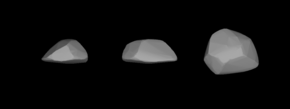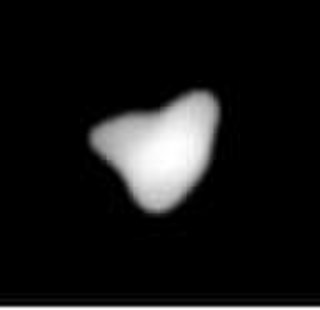
30 Urania is a large main-belt asteroid that was discovered by English astronomer John Russell Hind on July 22, 1854. It was his last asteroid discovery. This object is named after Urania, the Greek Muse of astronomy. Initial orbital elements for 30 Urania were published by Wilhelm Günther, an assistant at Breslau Observatory. It is orbiting the Sun with a period of 3.64 years and is spinning on its axis once every 13.7 hours.

38 Leda is a large, dark main-belt asteroid that was discovered by French astronomer J. Chacornac on January 12, 1856, and named after Leda, the mother of Helen of Troy in Greek mythology. In the Tholen classification system, it is categorized as a carbonaceous C-type asteroid, while the Bus asteroid taxonomy system lists it as a Cgh asteroid. The spectra of the asteroid displays evidence of aqueous alteration.

97 Klotho is a fairly large main-belt asteroid. While it is an M-type, its radar albedo is too low to allow a nickel-iron composition. Klotho is similar to 21 Lutetia and 22 Kalliope in that all three are M-types of unknown composition. Klotho was found by Ernst Tempel on February 17, 1868. It was his fifth and final asteroid discovery. It is named after Klotho or Clotho, one of the three Moirai, or Fates, in Greek mythology.

99 Dike is a quite large and dark main-belt asteroid. Dike was discovered by Alphonse Borrelly on May 28, 1868. It was his first asteroid discovery. This object is named after Dike, the Greek goddess of moral justice. Among the first hundred numbered minor planets, 99 Dike was considered anomalously faint for over a century. However, this was later found to be untrue.
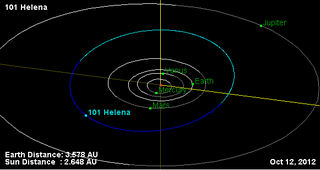
101 Helena is a large, rocky main-belt asteroid. It was discovered by Canadian-American astronomer J. C. Watson on August 15, 1868, and was named after Helen of Troy in Greek mythology.
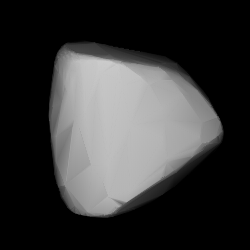
103 Hera is a moderately large main-belt asteroid with an orbital period of 4.44 years. It was discovered by Canadian-American astronomer James Craig Watson on September 7, 1868, and named after Hera, queen and fifth in power of the Olympian gods in Greek mythology. This is a stony S-type asteroid with a silicate surface composition.

108 Hecuba is a fairly large and bright main-belt asteroid. It was discovered by Karl Theodor Robert Luther on 2 April 1869, and named after Hecuba, wife of King Priam in the legends of the Trojan War in Greek Mythology. This object is orbiting the Sun with a period of 5.83 years and an eccentricity of 0.06. It became the first asteroid discovered to orbit near a 2:1 mean-motion resonance with the planet Jupiter, and is the namesake of the Hecuba group of asteroids.

110 Lydia is a large belt asteroid with an M-type spectrum, and thus may be metallic in composition, consisting primarily of nickel-iron. It was discovered by French astronomer Alphonse Borrelly on 19 April 1870 and was named for Lydia, the Asia Minor country populated by Phrygians. The Lydia family of asteroids is named after it.

111 Ate is a main-belt asteroid discovered by the German-American astronomer C. H. F. Peters on August 14, 1870, and named after Ate, the goddess of mischief and destruction in Greek mythology. In the Tholen classification system, it is categorized as a carbonaceous C-type asteroid, while the Bus asteroid taxonomy system lists it as an Ch asteroid.
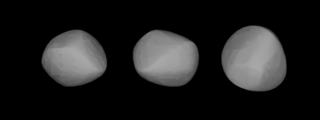
115 Thyra is a fairly large and bright inner main-belt asteroid that was discovered by Canadian-American astronomer J. C. Watson on August 6, 1871 and was named for Thyra, the consort of King Gorm the Old of Denmark. Based upon its spectrum, it is categorized as a stony S-type asteroid.

128 Nemesis is a large 180 km main-belt asteroid, of carbonaceous composition. It rotates rather slowly, taking about 78 hours to complete one rotation. Nemesis is the largest member of the Nemesian asteroid family bearing its name. It was discovered by J. C. Watson on 25 November 1872, and named after Nemesis, the goddess of retribution in Greek mythology.

131 Vala is an inner main-belt asteroid. It was discovered by C. H. F. Peters on 24 May 1873, and derives its name from völva, a prophetess in Norse paganism. One observation of an occultation of a star by Vala is from Italy. 10-μm radiometric data collected from Kitt Peak in 1975 gave a diameter estimate of 34 km.

133 Cyrene is a fairly large and very bright main-belt asteroid that was discovered by J. C. Watson on 16 August 1873 in Ann Arbor, Michigan, and named after Cyrene, a nymph, daughter of king Hypseus and beloved of Apollo in Greek mythology. It is classified as an S-type asteroid based upon its spectrum. It is listed as a member of the Hecuba group of asteroids that orbit near the 2:1 mean-motion resonance with Jupiter.

158 Koronis is a main-belt asteroid that was discovered by Russian astronomer Viktor Knorre on January 4, 1876, from the Berlin observatory. It was the first of his four asteroid discoveries. The meaning of the asteroid name is uncertain, but it may come from Coronis the mother of Asclepius from Greek mythology. Alternatively, it may come from Coronis, a nymph of the Hyades sisterhood. The Koronis family is named after this asteroid.

160 Una is a fairly large and dark, primitive Main belt asteroid that was discovered by German-American astronomer C. H. F. Peters on February 20, 1876, in Clinton, New York. It is named after a character in Edmund Spenser's epic poem The Faerie Queene (1590).

170 Maria is a Main belt asteroid that was discovered by French astronomer Henri Joseph Perrotin on January 10, 1877. Its orbit was computed by Antonio Abetti, and the asteroid was named after his sister, Maria. This is the namesake of the Maria asteroid family; one of the first asteroid families to be identified by Japanese astronomer Kiyotsugu Hirayama in 1918.
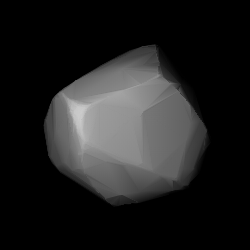
180 Garumna is a main belt asteroid that was discovered by the French astronomer Henri Joseph Perrotin on January 29, 1878. Its name comes from the ancient Latin name for the Garonne River in France. In the Tholen classification system, it is categorized as a stony S-type asteroid, while the Bus asteroid taxonomy system lists it with the Sr sub-type.

181 Eucharis is a large, slowly rotating main-belt asteroid that was discovered by French astronomer Pablo Cottenot on February 2, 1878, from Marseille Observatory. It was his only asteroid discovery. This object was named after Eucharis, a nymph from the 17th-century novel Les Aventures de Télémaque.

337 Devosa is a large Main belt asteroid. It was discovered by Auguste Charlois on 22 September 1892 in Nice. The asteroid is orbiting the Sun at a distance of 2.38 AU with a period of 3.68 years and an eccentricity (ovalness) of 0.14. These orbital elements are similar to that of the large asteroid 4 Vesta. The orbital plane of 337 Devosa is tilted at an angle of 7.85° to the plane of the ecliptic.

397 Vienna is a typical Main belt asteroid. It was discovered by French astronomer Auguste Charlois on 19 December 1894 in Nice, and was most likely named after the city of Vienna, Austria. This object is orbiting the Sun at a distance of 2.64 AU with an orbital eccentricity (ovalness) of 0.246 and a period of 4.28 yr. The orbital plane is inclined at an angle of 12.85° to the ecliptic.
